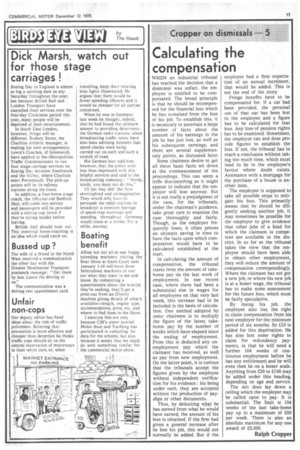Calculating the compensation
Page 21

If you've noticed an error in this article please click here to report it so we can fix it.
WHEN an industrial tribunal has reached the decision that a dismissal was unfair, the employee is entitled to be compensated. The broad principle is that he should be recompensed for the financial loss which he has sustained from the loss of his job. To establish this, it is necessary to ascertain a large number of facts about the amount of his earnings in the job he has just lost, as well as his subsequent earnings; and there are several supplementary points, as discussed later.
Some chairmen desire to get all these basic facts set down at the commencement of the proceedings. This can seem a trifle disconcerting as it might appear to indicate that the employer will lose anyway. But it is not really a prejudgment of the case, for the tribunals, under the chairman's guidance, take great care to examine the case thoroughly and fairly. Though, as the employer frequently loses, it often proves an ultimate saving in time to have the facts upon which compensation would have to be calculated established at the start.
In calculating the amount of compensation, the tribunal starts from the amount of takehome pay on the last week of employment. In one recent case, where there had been a substantial rise in wages for all employees on that very last week, this increase had to be included in the basis of calculation. One method adopted by some chairmen is to multiply the figure of the latest takehome pay by the number of weeks which have elapsed since the ending of employment. From this is deducted any unemployment pay which the claimant has received, as well as pay from new employment. On the latter point, it is curious that the tribunals accept the figures given by the employee without independent verification for his evidence : his being under oath, they are accepted without the production of payslips or other documents.
Thus, by deducting what he has earned from what he would have earned, the amount of his loss is obtained. If the firm had given a general increase after he lost his job, this would not normally be added. But if the employee had a firm expectation of an annual increment, that would be added. This is not the end of the story.
Fringe benefits have to be compensated for. If a car had been provided, the personal use of that car has been lost to the employee and a figure has to be calculated for that loss. Any loss of pension rights has to be examined. Sometimes, the employer can and does provide figures to establish the loss. If not, the tribunal has to reach a conclusion without taking too much time, which must tend to be in the employee's favour where doubt exists. Assistance with a mortgage for the purchase of a house is another item.
The employee is supposed to take all possible steps to mitigate his loss. This primarily means that he should be diligently seeking another job. It may sometimes be possible for the employer to give evidence that other jobs of a kind for which the claimant is competent are available in the district. In so far as the tribunal takes the view that the employee should have been able to obtain other employment, they will reduce the amount of compensation correspondingly. Where the claimant has not got a new job, or where his new job is at a lesser wage, the tribunal has to make some assessment for the future loss, which must be fairly speculative.
By losing" his job, the employee also lost the right to claim compensation from his next employer for the minimum period of six months. So CIO is added for this deprivation. He has also lost some rights to claim for redundancy payments, in that he will need a further 104 weeks of continuous employment before he has any entitlement and he will even then be on a lesser scale. Anything from £20 to £100 may be added under this heading, depending on age and service.
The Act does lay down a ceiling which the employer may be called upon to pay. It is substantial. The limit is 104 weeks of the last take-home pay up to a maximum of £50 per week. There is also an absolute maximum for any one award of £5,000.
Ralph Cropper














































































